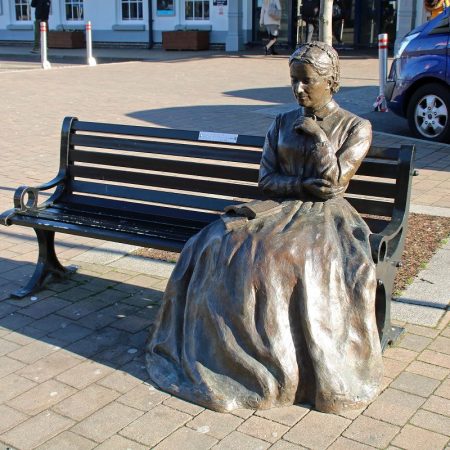The townscape of Hampshire owes itself to three main factors – trade, which made Southampton; defence, which made Portsmouth, as well as Aldershot and Farnborough; and administration and justice, which made Winchester.
London, too, ever greedy for space, has intruded itself into the county, inflating places like Basingstoke and Andover, and in one instance making a completely new town. This is Eastleigh, which has its roots in the opening of a rail line between Nine Elms terminus of the London and South Western Railway and Gosport.
The main line between London and Northam, Southampton, via Winchester, had opened in 1839, but two years later a branch line to Gosport with a junction near Little and Great Eastley Farms and the hamlet of Barton was constructed. At a time when a direct line from London to Portsmouth was beset by all manner of problems, the Gosport line took passengers to Portsmouth via a novel floating bridge.
The point of departure from the London and Southampton line was initially called Bishopstoke Junction, and then in 1889 Eastleigh & Bishopstoke, before becoming plain Eastleigh in 1923. A look at the map suggests that it might have been called Eastley or even Barton. But when in 1868 the novelist Charlotte Yonge, born in nearby Otterbourne, was asked to name a new parish made from parts of South Stoneham parish, she chose Eastley, but gave it what she called a ‘Frenchified’ spelling.
The fascinating story of the growth of Eastleigh has been told in a recent article by Howard Sprenger in the latest issue of the Hampshire Industrial Archaeology Journal (vol. 27, 2019). He explains how in 1847 a branch line to Salisbury was opened and five years later a County Cheese Market was set up at Bishopstoke. It was “held on the third Thursday of every month, when great quantities of cheese usually change hands,” according to White’s Directory of Hampshire of 1859.
The lands that became Eastleigh were variously owned by several wealthy local families. The Smythes of Brambridge, the Chamberlaynes of Cranbury Park, the Flemings of North Stoneham and the Heathcotes of Hursley. But it was Thomas Chamberlayne (and later his son Tankerville) who profited most from its development. His master stroke was to buy a part of the Brambridge Estate, which gave him “both component parts” of the new town. Later, many more houses were built by Jonas Nichols, memorialised in the Nicholstown part of Southampton between Bevois Valley and St Mary’s.
The population of Eastleigh rocketed when the LSWR decided that Nine Elms – a part of London now best known for Battersea Power Station and New Covent Garden Market – lacked space for its works, even though the terminus itself had in 1848 been extended to Waterloo. In 1851 Eastleigh had a population of 193, which had risen to 3,613 by 1891. In that year, the LSWR carriage and wagon works were transferred from Nine Elms, to Eastleigh, followed in the early 1900s by its locomotive works, which called for 4-5,000 new houses.
Any walk around Eastleigh will be hugely enriched by this excellent article. In the same issue are articles on A History of the Southampton Floating Dock, by Jerry N.J. Vondeling and on Cast Iron Gravestones and Memorials, by the late Tony Yoward. Copies of the journal are available from: Eleanor Yates, Danesacre, Worthy Road, Winchester SO23 7AD; 01962 852594; eleanor.yates@ntlworld.com.
-

The County Cheese Market for Hampshire, Bishopstoke, an engraving by Philip Brannon -

OS 6” map, 1872, Bishopstoke Junction, showing many features, including the branch lines to Gosport and Salisbury and the cheese market. -

Jonas Nichols, spec builder of houses in Eastleigh (The Southern Informer, No 20, 9 October 1880) -

Statue by Vivien Mallock of the Victorian novelist Charlotte Yonge, 2015, outside Eastleigh Station (Howard Sprenger) -

The Locomotive Engineers’ Club & Institute, Eastleigh, c.1980 (Eastleigh & District Local History Club)

